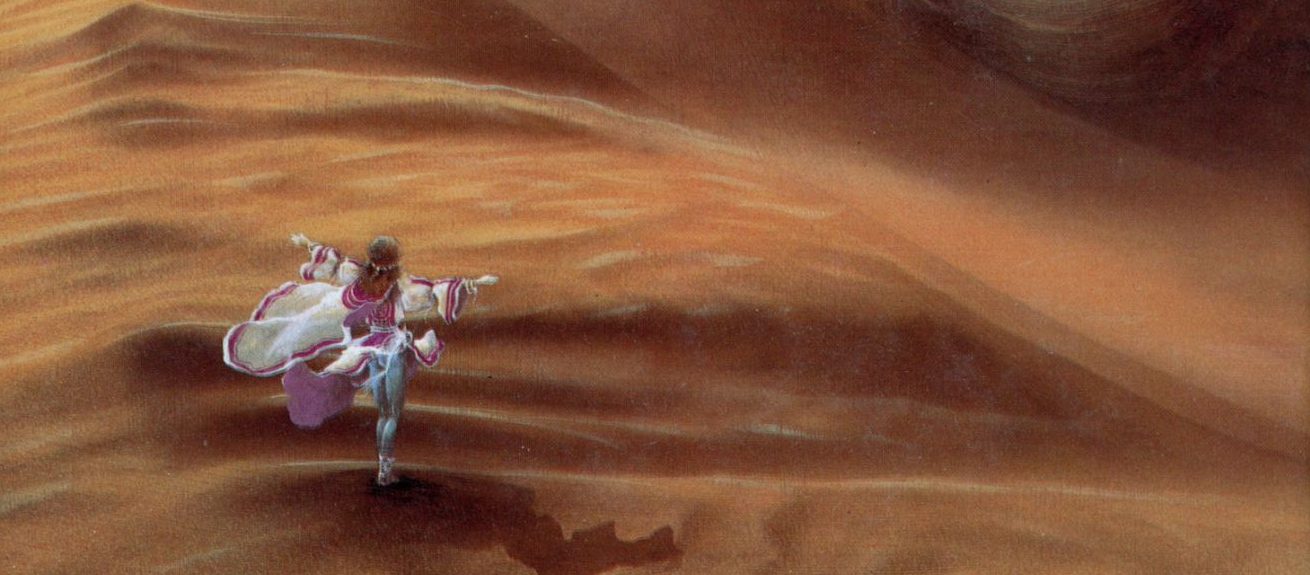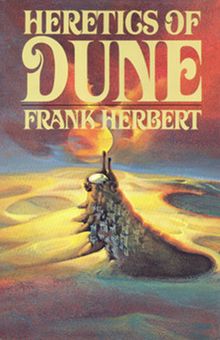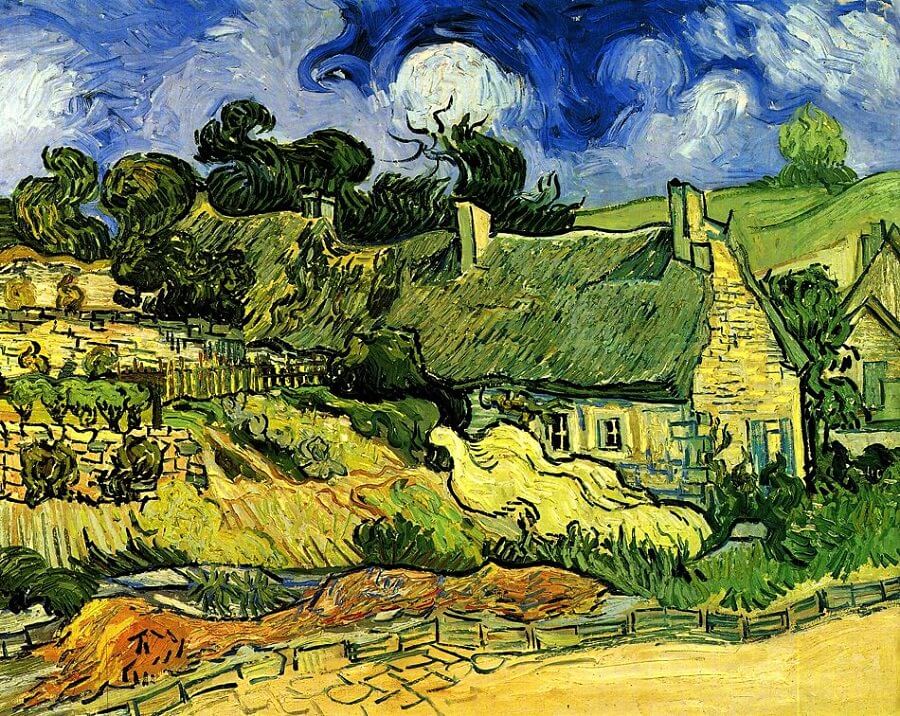

“Bureaucracy destroys initiative. There is little that bureaucrats hate more than innovation, especially innovation that produces better results than the old routines. Improvements always make those at the top of the heap look inept. Who enjoys appearing inept?”
Heretics of Dune is set 1500 years after the demise of Leto II at the end of his reign, which spanned several millennia and was the focus of the preceding novel in the series, God Emperor of Dune. Much has changed in the time between the novels; but a lot is still the same. The collapse of Leto’s empire resulted in the Scattering, a spreading out of humanity across the universe, incalculable in its scope. Heretics chronicles the power struggle in the galaxy that no longer has The Tyrant at its center. We have the steadfast and forward-thinking Bene Gesserit and their perverted offshoot known as the Honored Matres who have returned from the Scattering; the Bene Tleilax have discovered a method for growing spice melange in their axlotl tanks, refined their development of Face Dancers, and continue to hold to their ancient beliefs; the Ixians have built undetectable no-ships; and Leto’s consciousness is now apparently dispersed among the countless sandworms that once again populate Rakis (formerly Arrakis) and produce the economically powerful spice melange. The novel is a throwback to Dune, with much more action and verbal sparring rather than the philosophical musings of God Emperor. While some new elements are introduced, it is the first one that kind of feels like its treading previous ground. Not that Herbert was “cashing in” but more like he was content to write an adventure novel set in the universe he had created without trying to blow anyone’s mind like the previous novels attempted to.
On Rakis, the High Priests continue to worship The Divided God (Leto), and become subservient to a mysterious young girl named Sheeana who miraculously rides a sandworm out of the desert. She discovers that the worms obey her commands, and the priests believe she has been sent from God. For the umpteenth time, we have… wait for it… a ghola of Duncan Idaho.1 The Bene Gesserit have some grand plan for him that is mostly kept hidden from the reader. The Sisterhood has three characters with major roles in the novel—Mother Superior Taraza, along with Reverend Mothers Odrade and Lucilla. Schwangyu, another Reverend Mother, plays a dissident role as overseer of the Duncan ghola on Gammu (formerly Geidi Prime). They repeatedly reference the Sisterhood’s generational plan for the serial gholas that now must be hastened because of the rise of Sheeana, but in an act of betrayal Schwangyu permits the Bene Tleilax to attack their compound in an attempt to get their hands on Duncan.
One of my personal favorite characters in the series makes his appearance here: Miles Teg, a mentat and respected military commander of the highest rank. He is a result of the Bene Gesserit’s breeding program, and a distant descendant of the Duke Leto Atreides, mirroring him in both physical likeness and loyalty-eliciting charisma. After a long military career, he is living a secluded life on his home planet of Lernaeus, where he occupies his time with farming experiments. However, the Sisterhood call him out of retirement and send him to Gammu to train and protect the young Duncan, as well as to re-awaken his memories. He performs his function impeccably, shielding Duncan from the Bene Tleilax attack and escaping with him and Lucilla.
The plot and pacing are a stark contrast to God Emperor. It is full of political machinations, negotiations, religious shenanigans, assassination attempts, and escapes—remeniscent more of Children of Dune than perhaps any of the others. The Reverend Mothers are featured much more in this book than in any of the previous books in the series, with all three of Taraza, Lucilla, and Odrade getting plenty of dialogue and internal thoughts to develop our understanding of the Sisterhood. One of the parts I was most intrigued by was Odrade’s recurring fascination with a Vincent Van Gogh painting at the Bene Gesserit Chapterhouse. It is a human tendency to scoff at our ancestors and consider them primitive, but here is a work of art thousands of years old that can still evoke strong feelings in Odrade. Throughout the book Odrade is very strong willed and prone to indulge in forbidden emotions.
The thing dated from a time so ancient that only rare remnants such as this painting remained to send a physical impression down the ages. She had tried to imagine the journeys that painting had taken, the serial chance that had brought it intact to Taraza’s room.

The Reverend Mothers encounter Tylwyth Waff, a ruthless Tleilaxu Master who speaks for his people. We discover that not only have the Tleilax somehow changed the current Duncan Idaho ghola prior to delivery to the Bene Gesserit—so that he is suspected throughout to be some kind of wild card—but also that the Tleilax themselves somewhat rival the longevity of the Reverend Mothers as they achieve a faux-immortality by making gholas of themselves over and over. Most of these secrets are wrung out through careful thought by the individual Reverend Mothers. They even detect that Waff is a Zensunni, and convince him that the Sisterhood shares the same ancient religious beliefs, allowing the two factions to form an uneasy alliance.
After the attempt is made on Duncan’s life, he flees with Teg and Lucilla, finding haven in an ancient Harkonnen (remember them?) no-globe. When they try to come out weeks later, they are ambushed, and Teg makes a stand so the other two can escape. He is captured, and forced to endure a T-probe, a device of the Honored Matres used for reading thoughts of the living and dead alike, attached to the body through “medusa contacts.” The device causes Teg unbearable pain, but under the pressure of intense torture his body responds in an unexpected way—his awareness is heightened, and he finds himself physically capable of moving at blurring speed, which allows him to easily escape.
Duncan is captured, and we are made to understand, very explicitly, how the Honored Matres differ from the Bene Gesserit. The Bene Gesserit are sexually adept, but the Honored Matres use their skill to sexually enslave men. In excruciating detail, we also find out that the change the Tleilaxu made to this Duncan ghola allows him to overcome this sexual prowess and reverse its effect. Bleh.
Leto’s presence is never the main focus but it is felt by many of the characters. It is revealed that Taraza’s plan is to goad the Honored Matres into attacking and destroying Rakis, along with all of the sandworms, save one. Taraza is killed as the Honored Matres attack, and transfers her life memories into Odrade’s consciousness in her last moments. After loading the others onto a no-ship, Teg dies in the suicidal defense of Rakis. With Leto now more thoroughly destroyed, the Bene Gesserit plan to drown the last remaining sandworm, which will create abundant sandtrout and turn the Bene Gesserit Chapterhouse planet into a new Dune—but humanity will finally be out from under the prescient shadow of The Tyrant. The next book in the series (and last written by Herbert Sr.), Chapterhouse: Dune, is a direct follow-up to Heretics instead of the thousand year jumps between the previous few books.
After Leto’s death, a no-chamber containing his account of his reign was discovered at a site called Dar-es-Balat. Excerpts from it often serve as epigraphs to begin chapters, along with quotes pulled from Bene Gesserit archives. In the time of Heretics, Leto’s presence is still felt by those who either believe he still inhabits the worms (the Tleilaxu), or believe he simply had great foresight and predicted much of what occurs (the Sisterhood); but his harsh rule is replaced by a mish-mash of unexplained governing bodies. The Bene Gesserit have a military, but they pull the strings from behind the scenes and don’t directly rule anything; the priesthood seem to have some kind of nominal status and control of the official doctrine surrounding Leto’s mythology, but don’t wield any actual power.
Both the Honored Matres and the Tlielaxu try to make a play for dominance. The idea of Reverend Mothers detached from the community of the Sisterhood resulting in a perverted version of the Bene Gesserit is a good idea, and I think the repulsive result is at least partially intentional. I didn’t particularly enjoy the repeated allusions to their descent in sexual madness but the point was that their perverted use of it is also destroying them. The Tleilaxu are a bit underwhelming after spending so much of the preceding novels creeping around on the periphery and tantalizing the imagination. The discovery that the axlotl tanks are actually not mechanical tanks but rather simply the never-seen female Tleilaxu is alarming, but doesn’t leave you in awe like some of the evolutionary revelations of the preceding novels (such as the process by which sandtrout become sandworms, their interactions with the spice at different stages, etc.).
Sheena is an interesting character, coming out of nowhere and possessing incredible abilities, but she seemed a bit grafted on. In God Emperor, it made sense for humanity to evolve the ability to be invisible to prescience, and thus we had Siona. But why can Sheeana control sandworms? It is left mostly unexplained in Heretics.
Herbert gets to explore a bit more of the technology of the Dune universe. There has always been references to things that by now feel commonplace—glowglobes, stillsuits, lasguns, the gom jabbar—but even more are introduced here. A lot of these things are explored through the eyes of Teg, and his thoughts about them were always enjoyable interludes. At one various points, we consider the modern architecture in the crowded city of Ysai, Ixian probes, the no-ships and no-globes, axlotl tanks, nullentropy storage, restored Ixian groundcars, chairdogs,2 and “frame bush” houses (some kind of plant found in The Scattering that can grow into a dwelling).
Chaos was held at bay, although what pattern there was in the streets conformed to no master plan. Streets met and crossed at odd angles, seldom squared. Seen from the air, the place was a crazy quilt with only the giant black rectangle of ancient Barony to speak of an organizing plan. The rest of it was architectural rebellion.
At times, the writing can get a bit carried away with the characters doing things because they know they have to. We are given so much insight into their thoughts that keeping their plans from the reader makes the trickery a little bit too obvious. The writing is compelling and much more exciting (though less meaty) than God Emperor. Despite not matching the highs of previous books, it provides unique elements that make it a worthwhile continuation of the series.
1. It gets kind of tiresome to see the same character again and again; but really, each one is a “new” character until his memories are re-awakened, and his memories help Herbert tie the entire saga together across thousands of years.
2. Chairdogs—which seem to essentially be living massage chairs—are a weird and (in my opinion) unfortunate choice of crossing Herbert’s worlds. They originally appeared in Whipping Star (1970) which is one of several works set in his ConSentiency universe, and seem somewhat out of place in the Dune universe.
Sources:
Van Gogh, Vincent. Thatched Cottages at Cordeville. 1890.
Dude, I think there is a mistake in the first paragraph, but I have to say very interesting review. Thanks, Slappy.